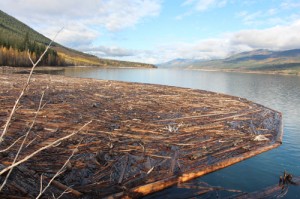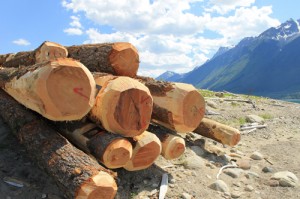
A report on the impacts of the Kinbasket Reservoir on Valemount and area, including three business cases to mitigate the impacts, is now available on the Village of Valemount’s website. The business cases propose assignment of allowable cut for forestry, geothermal exploration and local wetlands conservation to help remediate the impacts from the reservoir on the local environment and economy.
The Kinbasket Reservoir was created with the building of Mica Dam in the early 1970’s, part of the Columbia River Treaty with the United States to control flooding, mostly for the United States, and to improve the power production capacity of the Columbia River. The province of BC initiated community consultations on the future of the Treaty in November of 2012. In its summary report the province noted that many residents in the Valemount area recognized the reservoir is a huge revenue generator for the province, but felt that few benefits have come back to the community, and “compensation has not been adequate for the impacts experienced.”
As a result of local interest, the Village of Valemount, the Columbia Basin Trust and the Regional District of Fraser-Fort George decided to again review the impacts from the reservoir, and commissioned this study in early 2013 to compile a combination of past reports, public consultation and new research on the impacts and benefits of the reservoir.
First, the report looked at bio-physical and socio-economic impacts on Valemount and surrounding areas as a result of the creation of the reservoir. Impacts on forestry operations, including a loss of between 60,000 and 108,000 cubic meters of annual allowable cut, transportation access, tourism and recreation potential, loss of ecosystems and habitat, and impacts on local climate were reviewed.
The report estimates the financial benefits from Mica Dam and Kinbasket Reservoir at between $161 million and $252 million per year, going directly into the province’s Consolidated Revenue Fund. It says that according to local residents, the most meaningful compensation to the Valemount region to date was the creation of the Columbia Basin Trust, which is now self-sustaining and contributes to the environmental, economic and social health of the community.
The report then proposes economic development and environmental remediation opportunities, as identified in the public consultation sessions. It presents three business cases that address specific impacts from the reservoir, “and are an attempt to mitigate and/or remediate them.”

The first business case examines the assignment of the allowable cut within the Robson Valley Timber Supply Area as a strategy to improve local forestry and manufacturing related employment opportunities. It argues that re-allocation of timber volume in the Robson Valley area to local community forests will diversify the local economy, increase employment and associated provincial revenues, and ensure long-term environmental stewardship. It argues that without additional timber volume, Valemount’s forest industry will continue its decline to 15 workers, or 2.3 per cent of the labour force, within the next five years. The report says that decline can be reversed with additional volume, which would enable a diversified value added manufacturing sector, and suggests the additional volume could come from “a number of potential sources.”
The second business case looks at preliminary geological mapping in Valemount, with an eye to enabling district heating projects or other uses of geothermal direct heat. It proposes up to 10 steps that can be done successively, each step generally more expensive than the last, but building on information gained in earlier steps. The report proposes steps like initial data gathering, detailed mapping, and geophysical surveys should be started now, and says that understanding the geothermal resource available will help stimulate residential and commercial development, such as the Valemount Village Resort and Spa proposed by Saas Fee.
The third case proposes environmental remediation of a local wetland area to support natural ecological processes and existing plant and animal communities. The report says the creation of Kinbasket Reservoir inundated almost 6,000 hectares of wetlands as well as floodplains and shallow ponds, the biggest single event impacting wetlands in the region. It proposes benefits and improvements to the Starratt Wildlife Sanctuary (Cranberry Marsh) are a good opportunity to mitigate some of the ecosystem and recreational impacts of the reservoir. The marsh helps absorb and filter sediments, pollutants and excess nutrients, and recharges groundwater and deep aquifers. It also provides vital habitat to birds and other wildlife, and recreational and educational opportunities to residents and tourists. But all of these benefits are dependent on water levels, and the main source of water – McKirdy Creek – was diverted years ago into the Canoe River.
The sanctuary was designated a Provincial Wildlife Management Area in March 2013, which means it will now be managed by a single organization, the Ministry of Forests, Lands and Natural Resource Operations. The report says this is a positive step in that it will allow a single management plan that considers the entire ecological area. It recommends a water level monitoring program be initiated and potential water sources for the marsh and the rights to them be investigated. It also recommends both an invasive plant management plan and a closure to motorized traffic be implemented, and the establishment of a regional “Canoe View Park,” to provide regulated access and provide interpretive information.
Mayor Andru McCracken says he’d originally hoped the report would be some leverage, an opportunity to bring some domestic issues forward to the provincial government in the renegotiation of the Columbia River Treaty. He says it hasn’t paid off in that way, but it is a rich document, one that he studied before attending the Canadian Geothermal Energy Association’s conference in Calgary recently.
“Having that level of knowledge in the community and having the plan laid out for geothermal exploration is big,” says McCracken. He says the expansion of the community forest was already being pursued by Valemount Community Forest when the report was being written, but he hopes the community can make all of the plans come true.
The full report, Kinbasket Reservoir Impacts and Future Opportunities Report, was written by Jared Smith and Owen Torgerson and is available at http://www.valemount.ca/Documents.htm.



